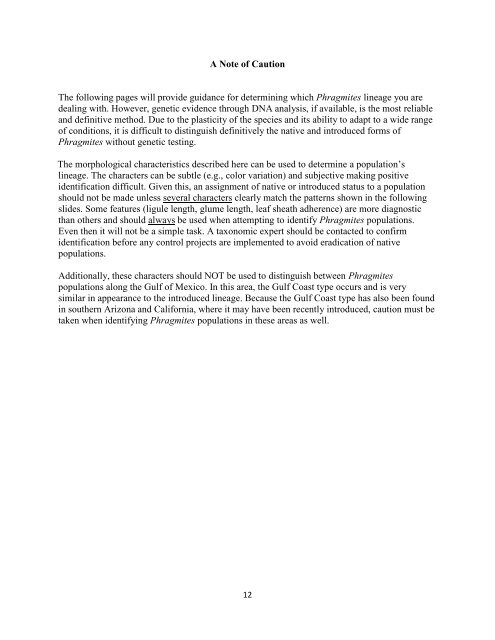Phragmites field guide: distinguishing native and exotic forms of ...
Phragmites field guide: distinguishing native and exotic forms of ...
Phragmites field guide: distinguishing native and exotic forms of ...
You also want an ePaper? Increase the reach of your titles
YUMPU automatically turns print PDFs into web optimized ePapers that Google loves.
A Note <strong>of</strong> Caution<br />
The following pages will provide guidance for determining which <strong>Phragmites</strong> lineage you are<br />
dealing with. However, genetic evidence through DNA analysis, if available, is the most reliable<br />
<strong>and</strong> definitive method. Due to the plasticity <strong>of</strong> the species <strong>and</strong> its ability to adapt to a wide range<br />
<strong>of</strong> conditions, it is difficult to distinguish definitively the <strong>native</strong> <strong>and</strong> introduced <strong>forms</strong> <strong>of</strong><br />
<strong>Phragmites</strong> without genetic testing.<br />
The morphological characteristics described here can be used to determine a population’s<br />
lineage. The characters can be subtle (e.g., color variation) <strong>and</strong> subjective making positive<br />
identification difficult. Given this, an assignment <strong>of</strong> <strong>native</strong> or introduced status to a population<br />
should not be made unless several characters clearly match the patterns shown in the following<br />
slides. Some features (ligule length, glume length, leaf sheath adherence) are more diagnostic<br />
than others <strong>and</strong> should always be used when attempting to identify <strong>Phragmites</strong> populations.<br />
Even then it will not be a simple task. A taxonomic expert should be contacted to confirm<br />
identification before any control projects are implemented to avoid eradication <strong>of</strong> <strong>native</strong><br />
populations.<br />
Additionally, these characters should NOT be used to distinguish between <strong>Phragmites</strong><br />
populations along the Gulf <strong>of</strong> Mexico. In this area, the Gulf Coast type occurs <strong>and</strong> is very<br />
similar in appearance to the introduced lineage. Because the Gulf Coast type has also been found<br />
in southern Arizona <strong>and</strong> California, where it may have been recently introduced, caution must be<br />
taken when identifying <strong>Phragmites</strong> populations in these areas as well.<br />
12
















